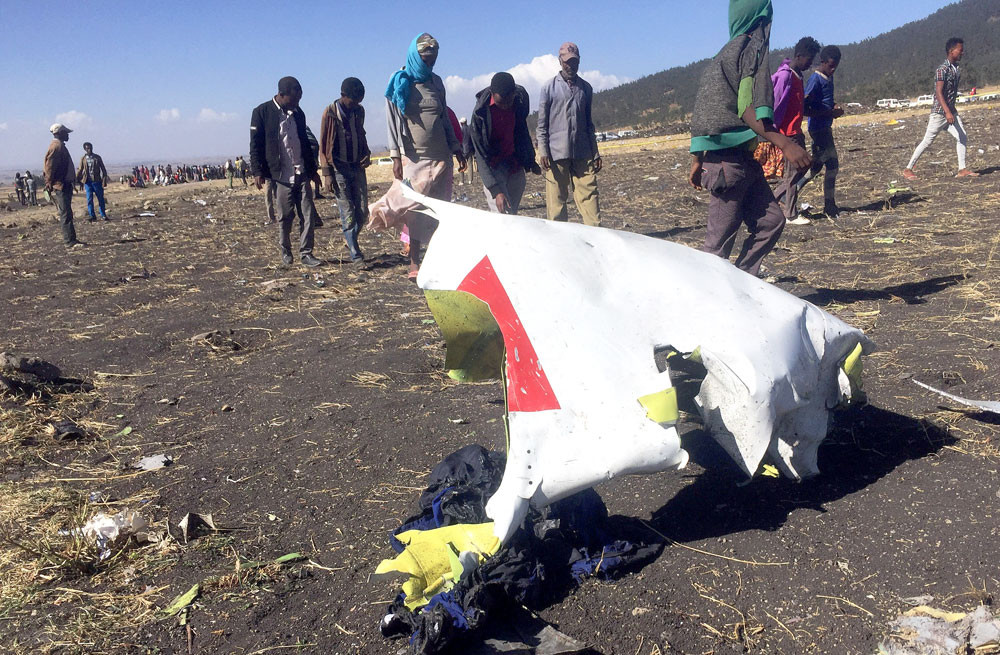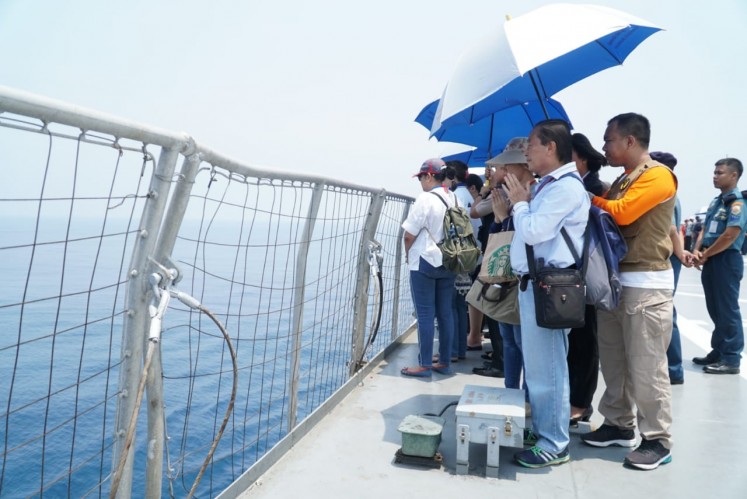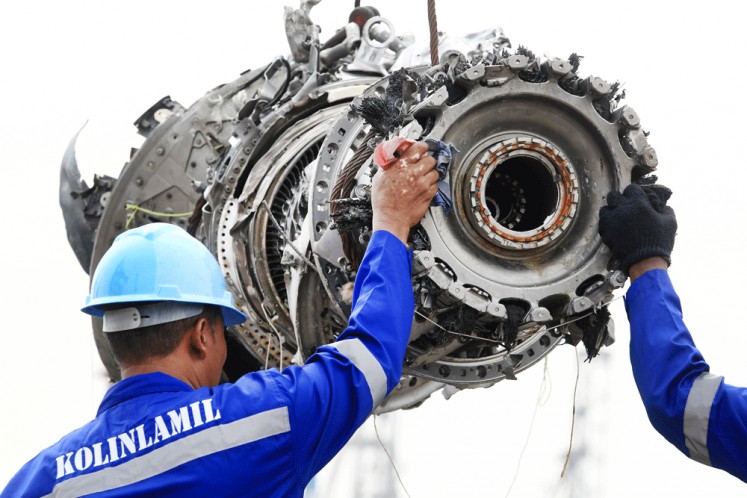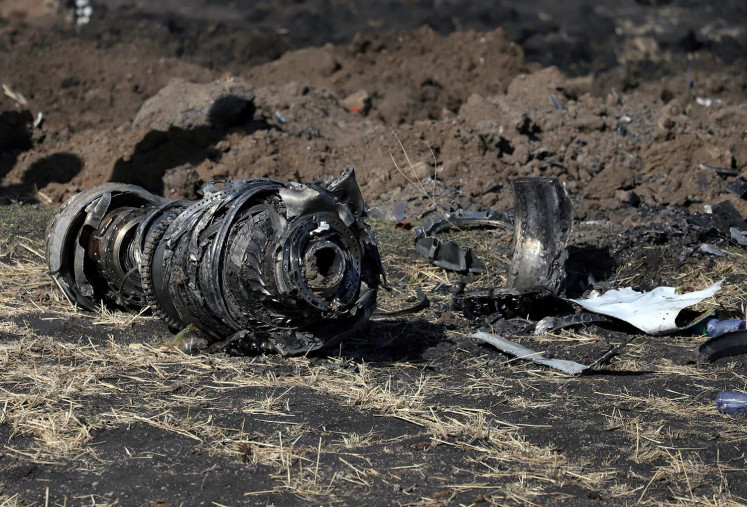Popular Reads
Top Results
Can't find what you're looking for?
View all search resultsPopular Reads
Top Results
Can't find what you're looking for?
View all search resultsSix similarities between Ethiopian ET302 and Indonesian JT610 plane crashes
The crashes killed a combined total of 346 people.
Change text size
Gift Premium Articles
to Anyone
A
n Ethiopian Airlines Boeing 737 carrying 149 passengers and eight crew crashed on Sunday morning local time en route from Addis Ababa, Ethiopia, to Nairobi, Kenya. The plane, a Boeing 737 MAX 8, was the same type as the ill-fated Indonesian Lion Air flight JT610 which crashed into the Java Sea in late October last year.
The flight ET302 accident killed all onboard, including one Indonesian. All 189 onboard flight JT610 also died. The crashes killed a combined total of 338 people.
Flight ET302 took off from Bole International Airport at 8:38 a.m. local time. Air traffic control (ATC) lost contact with the plane at 8:44 a.m.
The plane crashed near Bishoftu, a town some 60 kilometers southeast of Ethiopian capital Addis Ababa. There was a massive crater at the crash site with plane debris scattered widely, according to an AFP reporter. In a press conference on Sunday, officials from Ethiopian Airlines stated that by the time they arrived at the site, there was smoke.
Aside from the plane type, we found six similarities between the two devastating crashes:
1. Return to base request
In a press conference, the CEO of Ethiopian Airlines said the pilot had reported difficulties with the aircraft and requested to return to the airport. The request was approved by ATC.
The pilot of Lion Air JT610 had also requested to return to base just 2 to 3 minutes after takeoff from Soekarno Hatta International Airport in Tangerang, Banten. ATC gave clearance to return.
2. Lost contact within less than 15 minutes after takeoff
Flight ET302 took off from Bole International Airport at 8:38 a.m. local time and ATC lost contact with the plane at 8:44 a.m.
In the case of JT610, ATC lost contact with the plane at 6:33 a.m., shortly after it took off at 6:20 a.m. from Soekarno-Hatta International Airport.
Families of Lion Air JT610 plane crash victims pray for their loved ones at KRI Banda Aceh in the Java Sea on Nov. 6. (JP/Donny Fernando)3. Unstable vertical speed
Vertical speed reading of flight ET302 shows that the plane descended 2 minutes into the flight, before going up again briefly and then took another descent. The latest reading shows vertical speed of more than 2,000 feet per minute.
The vertical speed reading of JT610 made headlines due to a drastic nosedive near the end of its journey. The plane went down from an altitude of 4,850 feet (1,479 meters) in just 21 seconds, which was unheard of for a descent.
It was reported that the aircraft had a faulty sensor, causing difficulties for the pilot and resulting in the plane taking a steep dive. The Lion Air JT610 aircraft had faulty readings in its last four flights before the accident.
We have processed the granular ADS-B data received from #JT610. Last signal was received at 23:31:56.030 UTC from -5.81346, 107.12698 at 425 ft AMSL. Final ADS-B data received from the aircraft indicates a high rate of descent.
Data and context: https://t.co/QCUucGKVHr pic.twitter.com/bKoeAssrwE
— Flightradar24 (@flightradar24) October 29, 2018
4. Clear weather
According to Flightradar24, a Swedish internet-based service that shows real-time commercial aircraft flight information on a map, the weather during flight ET302 was clear with a visibility of more than 10 km.
METAR (weather data) from Addis Ababa Airport from the time when flight #ET302 took off. pic.twitter.com/Rvj4BAfpHe
— Flightradar24 (@flightradar24) March 10, 2019
The Meteorology, Climatology and Geophysics Agency (BMKG) also reported clear weather during the flight of JT610. The winds were relatively weak with no cumulonimbus clouds -- which usually cause flight turbulence.
5. New plane
The Boeing 737 MAX 8 aircraft was delivered to Ethiopian Airlines on Nov. 15, 2018. The aircraft’s registration was ET-AVJ with serial number 62450. Its first flight, operated by Boeing before delivery to the airline, was on Oct. 30, 2018, which was a day after the JT610 plane crash, according to Flightradar24.
The Lion Air JT610 aircraft was registered as PK-LQP. The aircraft was delivered to Lion Air on Aug. 13, 2018 and started flying with Lion Air on Aug. 18, according to Flightradar24. Aviation Safety Network database showed that the aircraft’s first flight by Boeing was on July 30, 2018.
6. Broken into pieces
Pictures taken from the Ethiopian Airlines ET302 crash site show that the plane broke into small pieces. The report from an AFP journalist also said that the "debris scattered widely".
The turbine of downed flight JT610 is unloaded from the KRI Banda Aceh onto Jakarta International Container Terminal (JICT) 2 in Tanjung Priok Port, North Jakarta, on Saturday. The turbine is being analyzed by the National Transportation Safety Commission (KNKT). (The Jakarta Post/Dhoni Setiawan ) Engine parts are seen at the scene of the Ethiopian Airlines flight ET 302 plane crash, near the town of Bishoftu, southeast of Addis Ababa, Ethiopia March 11, 2019. (Reuters/Tiksa Negeri)The same fate befell the aircraft of Lion Air JT610, and the search authority had to abandon their hope of finding the fuselage underwater as the plane was broken into small pieces.














